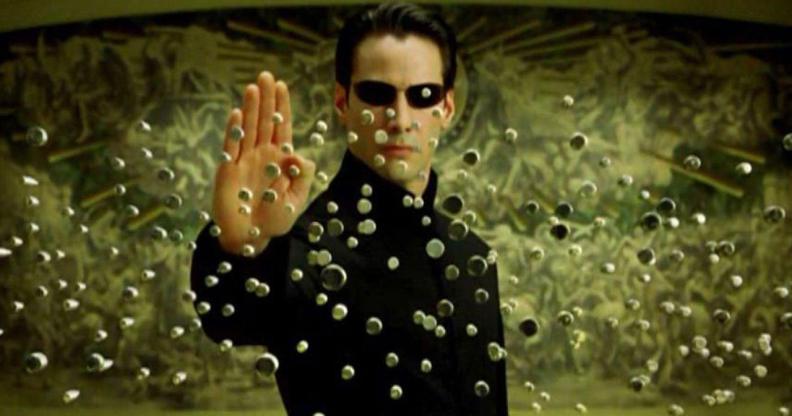6 ways The Matrix is a powerful metaphor for the trans experience

Critics have long suspected that The Matrix was a metaphor for the trans experience. (Warner Bros)
Critics have long suspected that The Matrix was a metaphor for the trans experience. (Warner Bros)
Lilly Wachowski has confirmed that The Matrix is a trans allegory – and as the fourth film, The Matrix Resurrections, is released, here’s a recap.
Lilly wrote and directed the original trilogy with her sister Lana Wachowski – though she chose to sit out The Matrix Resurrections, which hits cinemas Wednesday (22 December).
The sisters are Hollywood’s most powerful trans filmmakers, having both come out in the years after the trilogy’s release, and Lilly has said it was the duo’s “original intention” for the original Matrix to be read as a trans narrative.
“The Matrix was all about the desire for transformation, but it was all coming from a closeted point of view,” she told Netflix in an interview for its Film Club YouTube series.
“I love how meaningful those films are to trans people and the way that they come up to me say: ‘Those movies saved my life.’
“Because when you talk about transformation, specifically in the world of science fiction, which is just about imagination and world-building and the idea of the seemingly impossible becoming possible, that’s why it speaks it to them so much.
“And I’m grateful I can be a part of throwing them a rope along their journey.”
Queer critics have long interpreted the world of the Matrix through a trans lens, but for the uninitiated, Netflix rounded up some of the most notable metaphors in one easily-digestible Twitter thread.
1. The very concept of The Matrix
Quoting the book Females by Andrea Long Chu, it began by summing up the Matrix’s transness in the simplest of terms.
“Neo has dysphoria. The Matrix is the gender binary. The agents are transphobia.”
So how is THE MATRIX super trans? Writer @andrealongchu sums it up in an excerpt from her book “Females,” for Vulture: “Neo has dysphoria. The Matrix is the gender binary. The agents are transphobia.” https://t.co/uzyxpyfR2I pic.twitter.com/QLhFDZw1z6
— NetflixFilm (@NetflixFilm) August 6, 2020
2. Neo entering the real world and ditching his deadname
The scene in which Neo “wakes up” in the real world can be interpreted as the beginning of his transition.
Critic Willow Catelyn has previously noted how his decision to reject his birth name and start going by Neo is an obvious parallel to the trans experience.
Professor Eleanor Lockhart points out that the film’s villain, Agent Smith – who we now recognise as transphobia – insists on using Neo’s deadname throughout the series, with an emphasis on “mister”.
Critic @willow_catelyn writes about the significance of Neo rejecting an old name (ie his deadname) for a new one (his chosen name) in her thread about the film’s legacy:https://t.co/HfvyOg54K8
— NetflixFilm (@NetflixFilm) August 6, 2020
Interesting, isn’t it, how Agent Smith only refers to Neo as his deadname, Mr. Anderson, with a persistent emphasis on the “mister,” which Eleanor Lockhart, a professor at Rowan University, wrote about back in 2016. https://t.co/aQugibOzbu pic.twitter.com/PYBysiOyqQ
— NetflixFilm (@NetflixFilm) August 6, 2020
3. The Matrix’s famous ‘red pill’ has trans healthcare subtext
A detail as small as the colour of the pill which changes Neo’s word – red – takes on new significant when viewed through a trans lens. In the ’90s, Chu explained, estrogen was literally a red pill.
The rabbit hole goes deeper. As Chu writes, for years trans women have pointed out that in the ’90s, prescription estrogen was quite literally a red pill. pic.twitter.com/9YqMUDaXM9
— NetflixFilm (@NetflixFilm) August 6, 2020
4. Switch was supposed to be presented as trans
The biggest giveaway to the film’s true meaning might have been the character of Switch (Belinda McClory), had the Wachowskis had their way. Originally, Lilly has said, Switch was to present as a man in the real world, and as a woman in the Matrix.
There’s also the character Switch (Belinda McClory), who was originally written as a trans masculine person. As Lilly Wachowski says, her and Lana’s initial plan was for Switch to present as a man in the real world and a woman in The Matrix. pic.twitter.com/EBkJnN815N
— NetflixFilm (@NetflixFilm) August 6, 2020
Switch’s original identity as a trans masculine person dispels the notion that the Wachowskis have “retconned” the film after coming out. To any critics perpetuating this notion, Netflix gave a simple retort: “Who are you to tell not only a creator, but also a trans person, what was or wasn’t present in their minds while making their own film?”
While the Wachowski sisters coming out post-MATRIX may have prompted fans to revisit their filmography through a trans lens, they were always trans women and THE MATRIX is and always will be a film by two trans filmmakers.
— NetflixFilm (@NetflixFilm) August 6, 2020
5. Bullet time
Wrapping up its thread, Netflix notes how the film’s revolutionary visual effects can also be interpreted as representing the trans experience. Scholar Cael Keegan said as much in his book Lana and Lilly Wachowski: Sensing Transgender, which analyses the sisters’ place as the world’s most influential trans creators.
Look at bullet time: a technique to split time. Or as Keegan puts it, bullet time “gives the sensation of two temporalities at once… an effect resonant with the experience of gender transition and its multiple embodiments across time.” pic.twitter.com/VjuAYWuLwP
— NetflixFilm (@NetflixFilm) August 6, 2020
6. It was spelled out for us all along
Finally, the writer of the thread presents the end scene of The Matrix as perhaps the clearest sign of the Wachowskis’ intent.
Having defeated Smith and the Sentinels, Neo returns to the world of the Matrix. He makes a call promising the machines that he will free their prisoners.
“You’re afraid of us. You’re afraid of change,” he says before bursting into flight, triggering a “system failure”.
The last thing we see is the camera pushing between the letters M and F, “quite literally creating a space in between, and beyond, the gender binary”.
Lilly and Lana Wachowski gave us one of the most influential, enduring, and celebrated films of all time. Through THE MATRIX, they gave trans people the possibility of a cinematic world without borders or boundaries. A world where anything is possible.
— NetflixFilm (@NetflixFilm) August 6, 2020

